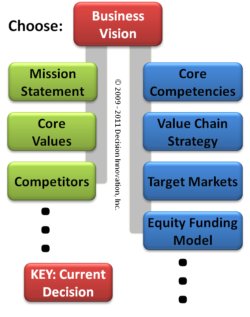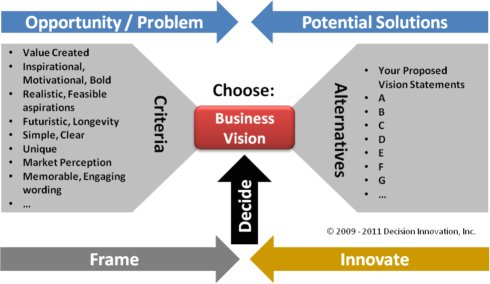Choosing a business vision statement
Does your business vision statement create a compelling image of the future for your business and/or industry? Do the people in your organization use your business vision as a guidepost for decision making, from strategic decisions through to operational decisions? Does your vision statement capture the idealism or "standard of excellence" that reflect the aspirations of the management team, inspiring thoughts of how the world could be if the company was highly successful?
 If not, it may be time to choose a new business vision. From our decision making model, this decision sits at the top of the decision network hierarchy, creating the opportunity to influence and guide decisions throughout the business or company. An effective business vision statement can have a huge influence on the allocation of resources and be an important tool in driving change.
If not, it may be time to choose a new business vision. From our decision making model, this decision sits at the top of the decision network hierarchy, creating the opportunity to influence and guide decisions throughout the business or company. An effective business vision statement can have a huge influence on the allocation of resources and be an important tool in driving change.
Distinguishing business vision from mission
These terms are often used interchangeably and can create confusion. To get the benefits of making these decisions we suggest the following distinction:
A business vision statement describes what the company aspires to be in the future (usually beyond 3 years), or how the world could be, in part, due to the company's efforts. The vision has the end result in mind and can provide the inspiration and reason for fulfilling its mission.
A business mission statement defines the fundamental purpose for the organization and the values it wants to reflect into the world. It represents the current state, and what the company will do, or contribute to, in fulfilling the aspirations of the vision.
Criteria for choosing a business vision statement
The following criteria are some of the most common success factors used in evaluating a business vision during the decision making process.
- Value created - A business vision should aim high and represent the creation of maximum value for its customers. Value characterizes the amount people will pay above the cost to deliver.
- Inspirational, motivational, bold - A business vision statement should inspire and motivate the business team, partners, and customers. It should represent a worthy, reach out aspiration.
- Realistic, feasible aspirations - The vision should be realistic and compatible with the core competencies of the business. The team should believe they can deliver on the vision.
- Futuristic, longevity - The business vision should stand up for a long time in the face of business and cultural trends.
- Simple, clear - Business vision statements should be simple and provide clarity and focus.
- Unique - A vision should be unique and distinguish the business from others.
- Market perception - The vision statement should represent and promote the business in the market place.
- Memorable, engaging wording - The wording of the vision statement should be easy to remember.
This set of criteria should lead to a good business vision, but only if you have a robust set of options to choose from.

Generating alternatives for your business vision statement
There are a number of approaches to identify or generate options that can be considered in making this choice. In most cases, this will start from a thoughtful look at why the business exists.
Here are two techniques that can be effective:
- Begin with the end in mind. Once you have a prioritized set of criteria for evaluating alternatives, you can start by generating statements that would measure well against your top three criteria.
Let's assume the top three criteria are value created, realistic aspirations, and futuristic, as described above. Begin by writing a statement that would assess well for each criterion. Using an energy company as an example, here are three possible statements:
- Value created: Our company creates value by providing the cleanest energy at the lowest cost.
- Realistic aspirations: With the world's experts in solar energy, we will change the way people meet their energy needs.
- Futuristic: Creating the energy for the next generation.
Using these three statements you can mix, match, and modify key phrases to create a number of options.
- For the industry you are in, identify some of your top competitors and write down their business vision statements. For each competitor, modify their vision statements to reflect what would be unique or different for your business.
Once you have a number of statements, similar to the previous technique, you can mix, match and modify to create a number of alternatives to use in choosing you business mission statement.
Why is the business vision so important?
Do not underestimate the impact this selection can have on your strategic decision making. For a new or small firm, a business vision can be critical to developing an organized plan.
When communicated effectively a business vision statement will:
- provide guiding requirements for decision making throughout the business decision network;
- create value for all stakeholders, including customers;
- build alignment and commitment at all levels of the organization;
- facilitate constructive change;
- serve as a roadmap for future decisions;
- inspire and motivate action even through tiring details; and
- prepare the business for the future.
A truly great vision will come to life in the everyday actions and behavior of the business team. It becomes part of the organization's culture.

Return from Business Vision Statement to Business Decision Making
